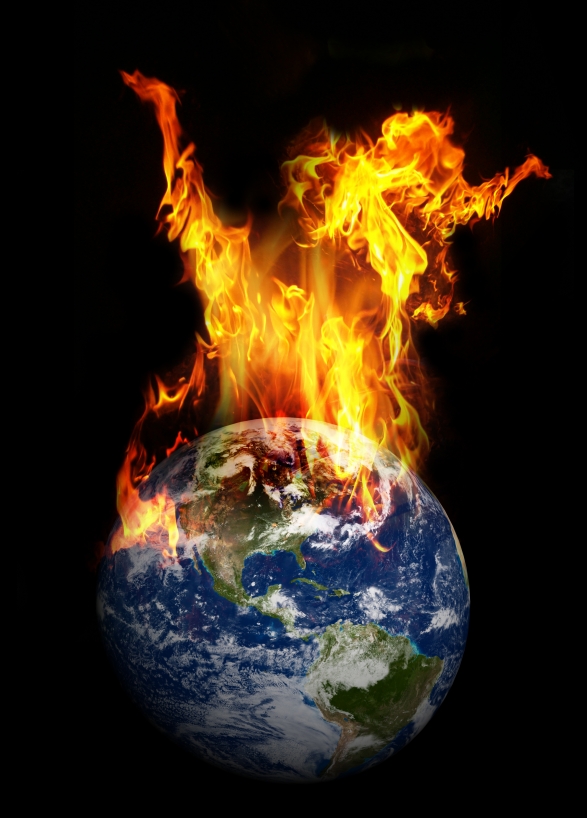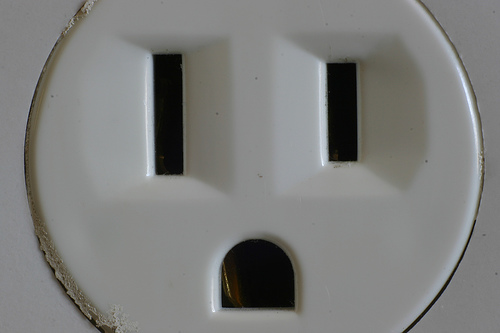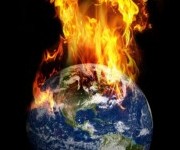 British scientist and author James Lovelock has just had published a follow-up book to his 2006 book, “The Revenge of Gaia: Earth’s Climate Crisis and the Fate of Humanity.” This 2009 one is entitled, “The Vanishing Face of Gaia: A Final Warning.” Throughout both books he presents scientific evidence to support his view that humankind has already caused so much damage to the Earth, burnt so much coal, oil and natural gas, cut down so many forests, and unthinkingly overdeveloped so many cities and towns in an environmentally destructive way, that the chances of humankind surviving a worldwide climate catastrophe are not that good.
British scientist and author James Lovelock has just had published a follow-up book to his 2006 book, “The Revenge of Gaia: Earth’s Climate Crisis and the Fate of Humanity.” This 2009 one is entitled, “The Vanishing Face of Gaia: A Final Warning.” Throughout both books he presents scientific evidence to support his view that humankind has already caused so much damage to the Earth, burnt so much coal, oil and natural gas, cut down so many forests, and unthinkingly overdeveloped so many cities and towns in an environmentally destructive way, that the chances of humankind surviving a worldwide climate catastrophe are not that good.
Lovelock believes that the likely result of our historic, short-sighted disregard for what he calls Gaia, “a self-regulating Earth with the community of living organisms in control,” (1) is the mass die-off of 85% or more of the human population over the course of this century. Despite this severely depressing belief, he has used his considerable intellect in these two books to try to think through how we can make the best of a very bad situation.
While generally supporting their work, he is critical of the Intergovernmental Panel on Climate Change, a United Nations-supported organization of 2,000 scientists who have been studying climate change since 1989. He is critical of them for underestimating the severity of climate change.
One example he uses of this failing is the forecast by the IPCC of a range of possibilities as to how much sea level would rise up to 2007. The forecast for the most amount of rise was less than what actually occurred. Another major example is what has been happening to Arctic sea ice. Lovelock points out that “the discrepancy is huge” between what was predicted and what has actually happened; “if melting continues at this rate the summer Arctic Ocean will be almost ice-free within fifteen years. The IPCC prediction suggests that this is unlikely before 2050.” (2)
I was glad to see Lovelock’s comparison of our situation today to that of the late ‘30s. “Most of us think that something unpleasant may soon happen, but we are as confused as we were in 1938 over what form it will take and what to do about it. Our response so far is just like that before the Second World War, an attempt to appease. The Kyoto agreement was uncannily like that of Munich, with politicians out to show that they do respond but in reality playing for time [much like what just happened in the House of Representatives ]. . . Battle will soon be joined, and what we now face is far more deadly than any blitzkrieg. By changing the environment we have unknowingly declared war on Gaia.” (3)
In both of his books Lovelock reviews the various major alternatives to a business-as-usual energy/economic scenario. Surprisingly, he is fiercely opposed to wind power, particularly on-land wind turbines (more on this later). He is a strong supporter of nuclear power, particularly more advanced plants that he says will produce very little radioactive waste. He believes that concentrated solar plants-what he calls solar thermal-have much potential as a replacement energy technology for fossil fuels. He has a full chapter in “Vanishing” about geoengineering; he doesn’t see the various proposals for this as “cures, since carbon dioxide would continue to increase and do damage in other ways than heating, but they could usefully provide a stay of execution while a more permanent treatment is developed.” (4)
Surprisingly, there is virtually nothing in either book about the importance of serious energy efficiency initiatives and requirements. Given that, for the United States, estimates are that there is potential for a 30-35% or more reduction in energy use if we took conservation and efficiency seriously, this is a major failing.
Similarly, there is little support in either book for the idea of “distributed power,” the decentralization of electrical power production via rooftop or backyard solar or small-scale wind power. Lovelock doesn’t see this approach as of value in the effort to slow our march toward climate catastrophe, and he doesn’t see it as of value to help local communities survive if that becomes our future.
Lovelock takes his belief in Gaia to a questionable place: the belief that, as he puts it in “Vanishing,” “Independence allows me to consider the health of the Earth without the constraint that the welfare of humankind comes first.” (5) He criticizes green activists for their concern for people and asks them to “think again and see that their primary obligation is to the living Earth. Humankind comes second.” (6)
What are his main ideas for what should be done? Nuclear power, some geoengineering to buy us some time, some carbon sequestration, a serious de-prioritization of the use of wind as an energy source, and non-wind renewables like concentrated solar plants. But “our greatest efforts should go into adaptation, to preparing those parts of the Earth least likely to be affected by adverse climate change as the safe haven for a civilized humanity.” (7)
Early on in “Revenge” Lovelock reveals his opposition to wind power. Indeed, as he explains on pps. 150-151, it was a proposal to build a wind farm in the countryside close to his home in late 2003 that “awakened me to the dangers” of imminent environmental change due to global heating. Lovelock’s account of how this “awakened my fury” reminded me of the opposition by the Kennedy family and other upper-class residents of Martha’s Vineyard in Massachusetts to plans to build an ocean-based wind farm off the coast because it would supposedly spoil their views of the ocean.
I was personally struck by the fact that it was in the fall of 2003 that this wind farm proposal galvanized Lovelock to seriously take up the global heating issue. It was in the summer of 2003 that something similar happened to me but for a different reason. For me, it was the death of 30,000 people during an unprecedented western European heat wave.
Lovelock minces no words when it comes to his view of humankind, which may help to explain his “earth first, humans second” worldview. “The idea that humans are yet intelligent enough to serve as stewards of the Earth is among the most hubristic ever.” (8) He believes that “we are over six billion hungry and greedy individuals,” (9) not exactly a generous or objective perspective on humankind.
This pessimistic view of human nature is consistent with his belief that the explosion of population across the globe-a “plague of people” (10) as he describes it—is a primary reason for our environmental plight. “It is not simply too much carbon dioxide in the air or the loss of bio-diversity as forests are cleared; the root cause is too many people, their pets, and their livestock-more than the Earth can carry.” (11)
Nowhere in Lovelock’s books is there any hint that the climate crisis might have something to do with the huge profits and power that have come from corporate control of oil, as well as coal and natural gas. In his view, “we are all the demons,” (12) as if the poor peoples of Africa, Latin America and Asia, not to mention low-income people in the countries of the Global North, are as responsible for our plight as those Exxon executives who have funded think-tanks for years with the explicit purpose of trying to deny the reality of global heating.
Lovelock sums up his view of the future toward the end of “Revenge:” “I think we have little option but to prepare for the worst and assume that we have already passed the threshold. Like paramedics, their first priority is to keep the patient, civilization, alive during the journey to a world that at least is no longer undergoing rapid change. We face unrestrained heat, and its consequences will be with us within no more than a few decades.” (13)
The one place where he puts a number on future world population is in “Revenge:” “I think we would be wise to aim at a stabilized population of about half to one billion, and then we would be free to live in many different ways without harming Gaia.” (14)
Within “Vanishing” he posits the areas of the world that he expects to be the places where human settlement will continue to be viable. “The northern regions of Canada, Scandinavia, and Siberia, where not inundated by the rising ocean, will remain habitable, and so will oases on the continents, mostly in mountain regions where rain or snow still fall. But the more important exceptions to this planet wide distress will be the island nations of Japan, Tasmania, New Zealand, the British Isles, and numerous smaller islands. Even in the tropics, global heating may not disable island communities such as those on the Hawaiian Islands, Taiwan, or the Philippines. The British Isles and New Zealand will be among the least affected by global heating. Their temperate oceanic position is likely to favor a climate able to sustain abundant agriculture. They will be among the lifeboats for humanity.” (15)
What will be our gravest dangers? “Not from climate change itself, but indirectly from starvation, competition for space and resources, and war.” (16)
Warlords? Yes, of course. “Despite all our efforts to retreat sustainably, we may be unable to prevent a global decline into a chaotic world ruled by brutal war lords on a devastated Earth.” (17)
As far as what we do now to prepare for, in Lovelock’s view, a likely Great Catastrophe [my phrase], he has some specific and a number of general ideas.
In “Revenge” he calls upon the leaders of his country to “make decisions based on our national interest. . . We should not wait for international agreement or instruction. In our small country we have to act now as if we were about to be attacked by a powerful enemy. We have first to make sure our defenses against climate change are in place before the attack begins.” (18)
He reiterates and amplifies in disturbing ways this recommendation for the British elite in “Vanishing:” “There will be time enough for internationalism during the stability of the long hot age. We have no option but to make the best of national cohesion and accept that war and warlords are part of it. For island havens an effective defense force will be as important as our own immune systems. Like it or not we may have to increase the size of and spending on our armed forces.” (19)
He calls for people to begin to prepare to “move where it is safe. . . Those who leave for the cooler, still fertile regions have a better chance of surviving, and if enough of us are saved this way it could benefit Gaia as well. . . Our greatest efforts therefore should go to learning how to live as well as is feasible on the soon-to-be-diminished hot Earth.” (20)
He analogizes the situation he believes we will be facing with a lifeboat. And by “we” it is very clear that he is writing from the perspective of a member of the British elite. “Soon we face the appalling question of whom we can let aboard the lifeboats. And whom must we reject? There will be no ducking this question for before long there will be a great clamor from climate refugees seeking a safe haven in those few parts where the climate is tolerable and food is available. Make no mistake, the lifeboat simile is apt; the same problem has faced the shipwrecked: a lifeboat will sink or become impossible to sail if too laden. The old rules I grew up with were women and children first and the captain goes down with his ship. We will need a set of rules for climate oases.” (21)
A new set of rules. Would those rules in a world going through the Great Catastrophe be much different than the current “rules” which have given us a world where the financial assets of about 400 people, 400 billionaires, is roughly equal to the annual income of almost half of the world’s people? “Rules” under which those most responsible for global heating, the owners and CEO’s of the world’s fossil fuel companies and related industries and the politicians who do their bidding, will continue to be among the small group who make the decisions about who lives and who dies?
Or can we create for ourselves in enough time societies governed by a new set of “rules,” a new way of organizing ourselves, a new way of living with the earth and with one another? Can we create a new way that we live as individuals, day-to-day, that builds upon the life examples and teachings of history’s great spiritual leaders, or the life examples of the tens of millions, if not hundreds of millions, who have come before us who gave their lives struggling and sacrificing for a better world for their descendants?
There are many of us all around the world who believe, unlike Lovelock, that we have it in us not just to try but to have a chance of succeeding. But it’s a race against time.
(This is a condensed version of a longer article. Send an email to usajointheworld [at] igc.org to obtain a copy of that longer version.)
Ted Glick’s other writings are archived on his website.
Footnotes:
1) The Vanishing Face of Gaia, p. 159
2) Vanishing, p. 4
3) The Revenge of Gaia, p. 10
4) Vanishing, p. 145
5) Vanishing, p. 35
6) Revenge, p. 121
7) Vanishing, p. 68
8) Revenge, p. 152
9) Revenge, p. 7
10) Revenge, p. 3
11) Vanishing, p. 5
12) Vanishing, p. 110
13) Revenge, pps. 152-153
14) Revenge, p. 141
15) Vanishing, p. 17
16) Vanishing, p. 31
17) Revenge, p. 154
18) Revenge, p. 13
19) Vanishing, p. 95
20) Vanishing, pps. 85-86
21) Vanishing, ppps. 247-248




